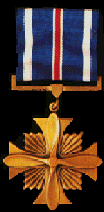
|

|
 The President of the United States takes pleasure in presenting the DISTINGUISHED FLYING CROSS to MAJOR JAMES WILLIAM WARNER UNITED STATES MARINE CORPS for service as set forth in the following CITATION: "For heroism and extraordinary achievement in aerial flight while serving as a Pilot with Marine Medium Helicopter Squadron 364, Marine Aircraft Group Thirty-Six, First Marine Aircraft Wing in connection with operations against the enemy in the Republic of Vietnam. On the morning of 15 March 1968, Major Warner launched as the Flight Leader in a flight of eight CH-46 helicopters assigned the emergency resupply of a Marine outpost on Hill 881 South near the Khe Sanh Combat Base. After receiving a 4,000 pound external load of medical supplies at Dong Ha, he expeditiously navigated his aircraft to the designated areas, and as he approached the landing zone, the helicopter immediately came under a heavy volume of North Vietnamese machine gun and mortar fire. Disregarding his safety, he resolutely maneuvered his aircraft into the hazardous position and, ignoring the hostile rounds impact- ing near him, commenced a precarious hover. Although his helicopter was repeatedly struck by enemy machine gun rounds, he steadfastly maintained the aircraft in the dangerously exposed position and, after disconnecting the cargo, departed the zone. Despite his helicopter's critical shortage of fuel, he resolutely remained above the fire-swept position while directing the other aircraft of his flight in completing the resupply. His bold initiative and superb airmanship inspired all who observed him and contributed immeasurably to the accomplish- ment of the hazardous mission. Major Warner's courage, superior professional ability and steadfast devotion to duty in the face of great personal danger were in keeping with the highest traditions of the Marine Corps and of the United States Naval Service." FOR THE PRESIDENT /S/ H. W. Buse, Jr. H. W. BUSE, JR.
|
| The original recommendation for this Distinguished Flying Cross, and the after action reports for all eight aircraft, reveal much more than reflected in the above citation. The weather was bad with Dong Ha having a 1,500 ceiling. Therefore, individual aircraft made radar controlled departures out of Dong Ha to an altitude of approximately 3,500 on top where all eight joined up in formation at a rendezvous point near the Khe Sanh Combat Base. The flight remained over Khe Sanh for about thirty minutes while Marine A-4s "prepped" the terrain surrounding Hill 881S with bombs and rockets. In addition to the 29,500 pounds of cargo delivered to Hill 881S, the flight of eight also supplied Hills 558 and 861 with 28,500 and 26,000 pounds of cargo respectively. In addition to the hits received by Major Warner's aircraft, the Command Chronology for 15 March indicates three additional aircraft received battle damage to cockpits, passenger compartments and rotor blades. All continued to fly the rest of the day. Major Warner's 4,000 pounds of cargo for Hill 881S contained some critically needed medical supplies and explains why he took so long in gingerly placing it on the hill instead of "pickling" it. The eight aircraft logged a total of 41.1 flight hours resupplying the hill positions. |
The Crew of YK-17
| Maj. James W. Warner
1stLt. J. J. Smith Cpl. T. L. Springer Cpl. W. R. Brown Sgt. G. W. Lobdell |
Pilot
Copilot Crew Chief Gunner Gunner |
Back Browser or Home
-